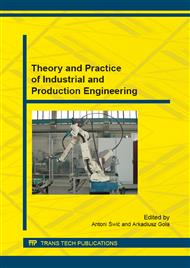p.224
p.232
p.238
p.246
p.252
p.259
p.266
p.272
p.281
The Effect of Alloy Cast Iron Hardness on the Tribological Properties of a Bronze – Cast Iron Pair in Dry and Mixed Friction
Abstract:
The paper reports the results of model testing of dry and mixed friction wear of a worm – worm rack kinematic pair, where the worm is made of CUA19Fe3 bronze, while the rack of alloy cast iron. Such a pair is applied in the feed mechanisms of heavy-duty machine tools. The experiment was conducted with variable cast iron hardness values and pressure levels. The distribution of wear along the friction path for the both elements of the tribological pair has been determined. The results are presented in diagrams and in the form of a relationship of wear intensity as a function of the parameters examined in the experiment.
Info:
Periodical:
Pages:
252-258
Citation:
Online since:
September 2015
Authors:
Keywords:
Price:
Сopyright:
© 2015 Trans Tech Publications Ltd. All Rights Reserved
Share:
Citation:


